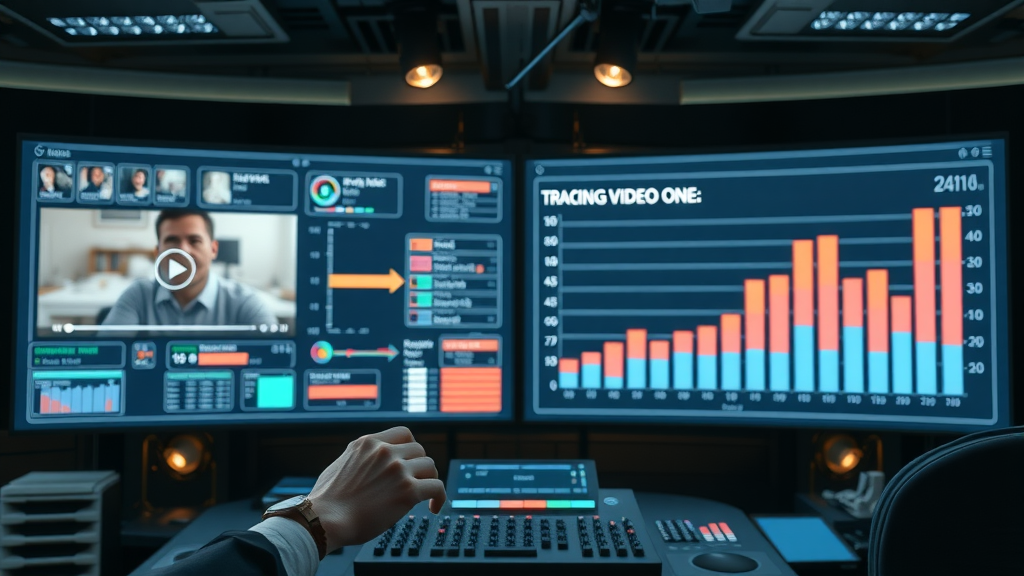Did you know businesses using video marketing analytics see up to 49% faster revenue growth? This isn’t just another digital marketing trend—it’s a real transformation tool for any marketing strategy. When you unlock the power of video analytics, you stop guessing and start making informed decisions based on actual audience behavior, engagement metrics, and marketing analytics. Let’s dive into how video marketing analytics delivers such rapid, measurable results and how you can start benefiting today.
Unlocking the Power of Video Marketing Analytics: Surprising Stats You Need to Know

- Did you know that businesses using video marketing analytics see up to a 49% faster growth in revenue? Discover why leveraging analytics can transform your video marketing strategy from average to exceptional.
The impact of video marketing analytics stretches far beyond basic views and likes. Recent research shows that 87% of marketers report positive ROI from video marketing analytics, and 95% plan to increase their video content investments. Video marketing analytics allows you to track every key metric—from watch time to engagement rate and conversion rate—fueling smarter decisions and continuous improvement.
What sets successful brands apart isn’t just producing amazing video content; it’s their ability to measure, analyze, and optimize every campaign. Imagine knowing not only how many people watched your video, but also pinpointing exactly which scenes kept the audience hooked and what actions viewers took next. This level of insight—powered by analytics—translates directly into a better bottom line, higher brand awareness, and dramatically improved marketing strategy.
Why Video Marketing Analytics Matter for Every Marketing Strategy
Integrating video marketing analytics into your marketing platform is no longer optional—it's essential for anyone serious about results. By tracking key metrics such as engagement rate, watch time, and conversion rates, marketers can optimize their strategies and maximize ROI. With video playing an ever-increasing role in engagement, understanding how your target audience interacts with your content is critical for growth.
Video analytics doesn't only serve big brands. Small and mid-sized businesses can also harness the power of marketing analytics to fine-tune every video campaign. Whether your goal is to boost brand awareness, drive web traffic, or skyrocket conversions, analytics tools offer a data-driven pathway to success. It's about more than tracking views; it's about turning every piece of video content into a measurable, high-impact marketing asset.
In today’s digital marketing landscape, the winners are those who understand their audience in depth. With comprehensive video analytics, marketers discover what works—and what doesn’t—allowing them to continuously improve both creative content and delivery methods. From real-time engagement metrics to advanced campaign tracking, utilizing video marketing analytics is the difference between hoping for results and guaranteeing them.
Integrating Video Analytics Into Your Marketing Platform

Integrating video analytics into your marketing platform unlocks actionable data that transforms your entire marketing approach. Marketers can connect video performance metrics with other digital marketing channels, creating a unified view of customer behavior. By setting up advanced dashboards, your team can monitor key metrics in real-time—helping you quickly adjust and optimize your video marketing strategy.
Imagine a collaborative team reviewing a new campaign’s engagement metrics on an interactive dashboard. With seamless integration, each department—content creation, social media management, analytics—has access to the same data, ensuring that everyone is aligned around audience insights and campaign goals. This fosters a culture of data-driven decision-making and helps marketing teams respond quickly to viewer engagement trends.
Best-in-class marketing platforms even let you link video content success metrics with broader marketing analytics, like website traffic sources and sales conversions. Once you have these systems integrated, measuring the bottom line impact of every video becomes effortless, allowing you to continually optimize and scale your strategies for even better results.
Case Study: How Video Marketing Analytics Revealed Hidden Opportunities
Let’s look at a real-world scenario: a retail brand ran a new video campaign to boost brand awareness and online sales. By closely monitoring watch time, drop-off rates, and post-view conversion analytics, marketers identified that viewers spent more time watching a mid-point product demonstration than any other segment. Using this insight, they refocused future video content around similar product demonstrations, resulting in a 27% increase in engagement rate and a record rise in sales.
Without analytics, these high-performing moments would have remained hidden, missing the chance to capitalize on powerful audience interest. This case demonstrates how vital it is to dig past surface-level metrics, using in-depth video analytics to uncover where your audience’s interest peaks—and how to replicate that success in future campaigns.
The right analytics not only reveal what isn’t working—they shine a light on the marketing moments that matter most. By leveraging these insights, companies can launch more informed, impactful campaigns and move their marketing strategy from trial-and-error to strategic dominance.
The Core Metrics: Video Marketing Analytics Every Strategist Needs
Knowing which video metrics to track is half the battle in marketing analytics. The most effective marketing strategies are supported by a solid understanding of the metrics that actually drive business outcomes, such as watch time, engagement rate, conversion rate, and traffic source.
Not all metrics are created equal. Instead of being distracted by vanity numbers, savvy strategists focus on the analytics that reveal true audience engagement and bottom line impact. By consistently monitoring these core metrics, you’ll know exactly where to invest your marketing resources for maximum effect.
Let’s explore the critical analytics every video marketer needs in their toolkit—so you can optimize your video campaigns and exceed your KPIs time and again.
Essential Engagement Metrics: Watch Time, Engagement Rate, and Beyond
The most crucial engagement metrics in video marketing analytics include watch time, engagement rate, and play-through rate. Watch time measures the total amount of time viewers spend watching a video, revealing not just how many clicked “play,” but how deeply your content resonates with your target audience. The engagement rate blends metrics like likes, shares, comments, and click-throughs, delivering an at-a-glance view of active audience interaction.
Play-through or retention rates pinpoint exactly where viewers spend watching—spotting parts of your video content that captivate versus cause drop-offs. Using these analytics, marketers can determine which video segments need refinement or which call-to-actions are most effective.
Consistently tracking and comparing these key metrics across videos lets you identify best practices, common patterns, and unique audience preferences—giving you a clear playbook for future video success.
Measuring Video Performance: From Traffic Source to Conversion Rate

To truly understand video performance, you must look beyond simple view counts to traffic source and conversion rate. Traffic source analytics show where viewers are coming from—Google search, social media, email campaigns, or direct website visits. Knowing this allows marketers to double down on platforms driving the best audience engagement.
Conversion rate analysis tracks how effectively your video content moves viewers to action, whether that’s filling out a form, subscribing to a newsletter, or making a direct purchase. Tying these conversions directly back to specific videos or campaigns makes it easy to justify marketing spend and refine your strategy for even greater impact.
By combining traffic source data with granular conversion rates, you unlock the full story of your video campaigns—helping you identify the highest-ROI channels, refine messaging, and consistently optimize your video for stronger results.
Utilizing Marketing Analytics for Video Campaign Success
The power of marketing analytics lies in the ability to quickly identify what works and pivot when it doesn’t. By continuously reviewing real-time metrics for each video campaign , marketers can spot upward or downward trends before they significantly affect the bottom line.
For example, if your engagement rate suddenly drops, analytics can reveal whether the cause is a change in video content, targeting, or even promotional channels. This rapid feedback loop allows you to test new ideas, iterate quickly, and always stay a step ahead of your competition.
In short, using analytics enables data-backed decision-making at every stage. From the brainstorming phase to content optimization and campaign scaling, every action is guided by measurable results—and that’s the secret to consistent video marketing success.
How Video Marketing Analytics Shapes High-Impact Video Marketing Strategies
Video marketing analytics are the secret weapon behind every successful video marketing strategy . By providing detailed insights on viewer behavior, campaign performance, and overall video content effectiveness, analytics empower marketers to craft high-impact campaigns built to deliver results.
Gone are the days of producing content and hoping for the best. With analytics, marketers can spot patterns, address weaknesses, and amplify what works—creating a repeatable blueprint for success. By aligning video metrics to overarching business objectives, every campaign becomes another step toward greater market share, deeper audience connection, and maximized ROI.
Consistently using video analytics to inform creative and strategic decisions ensures your marketing platform stays agile and effective in a rapidly changing digital marketing landscape.
Optimizing Your Video Content Using Video Analytics
To truly optimize your video content, you need more than just an idea—you need insights. By reviewing watch time, drop-off points, and interaction hotspots, marketers can edit and adjust videos to cater to their audience’s genuine interests. For instance, if analytics show the opening 10 seconds lose viewers, refining your introductions could dramatically boost engagement metrics.
A/B testing different video styles or call-to-actions, informed by actual performance data, can uncover surprising trends—like which editing choices or topics best drive viewers to take action. In this way, analytics provide a reliable compass, ensuring each video iteration gets stronger, smarter, and more effective with every campaign.
In practice, continuous content optimization, powered by analytics, means you move from producing “good enough” videos to creating high-impact, personalized stories designed to maximize conversions.
A/B Testing Campaigns for Optimal Engagement and Performance

A/B testing is the backbone of data-driven video marketing. By simultaneously running two different versions of a video campaign or video thumbnail, marketers can pinpoint which creative elements truly drive higher engagement rate , longer watch time, and improved conversion rate .
Imagine testing two video intros—one with animation, the other with a direct speaker introduction. By tracking watch time and click-through from each, marketers gain actionable insights about what audiences prefer. These tests can also evaluate video length, graphics, calls-to-action, or editing style—giving you the hard data needed to refine every creative element.
Ultimately, ongoing A/B tests, powered by robust video marketing analytics, empower marketers to optimize campaigns for maximum ROI and continuous improvement.
Aligning Video Metrics with Your Digital Marketing Strategy Goals
Successful campaigns begin with clear objectives—and aligning video analytics with your digital marketing strategy ensures you’re measuring what matters. Marketers should map each video metric —like engagement rate, traffic source, and conversion rate—to specific business goals, whether it’s boosting subscriptions, driving direct sales, or increasing site traffic.
This alignment transforms raw data into actionable insights. For instance, if your main objective is lead generation but analytics show viewers drop off before the sign-up form, it’s a signal to adjust content placement or messaging.
This focused approach ensures that every marketing action is data-driven, results-focused, and tailored to move the needle on your unique business priorities.
Harnessing Social Media and Video Marketing Analytics Together
Integrating social media analytics with video marketing analytics is a game-changer. Today’s viewers often interact with video content across platforms—YouTube, Facebook, Instagram, Twitter, and LinkedIn. Measuring how each channel drives awareness, engagement, and conversions offers a full-spectrum view of your campaign’s reach and effectiveness.
With unified analytics, marketers can identify top-performing videos per platform, optimize distribution strategies, and track which social posts drive the most website visits or conversions. This ensures they don’t miss opportunities to engage or retarget audiences on the channels that matter most to their bottom line.
The result? More informed social promotion, higher engagement metrics, and a cohesive digital marketing strategy that leverages the collective power of video and social media.
Tracking Engagement Metrics Across Social Media Platforms

Social media engagement metrics—shares, likes, comments, and click-throughs—help marketers understand what resonates with diverse audiences. Advanced analytics platforms make it easy to compare these metrics across Facebook, Instagram, Twitter, and emerging platforms, revealing which types of videos gain the most traction and where your target audience spends the most time watching.
These insights let you pinpoint best posting times, ideal video length, and optimal creative approaches for each channel. For example, short videos may perform best on Instagram, while longer, educational content generates high engagement on YouTube.
By leveraging social media analytics, you can continually refine your content calendar and promotional tactics for each platform, ensuring maximum visibility and engagement across your entire digital presence.
Boosting Social Media ROI with Video Analytics
Combining video and social media analytics empowers you to optimize every campaign for higher returns. By measuring video-driven conversions, follower growth, and audience retention, marketers can tie each campaign directly to business outcomes like increased site traffic or online sales.
Marketers can identify high-performing video content and double down on social platforms where audiences are most likely to share, comment, or click through. This approach turns social video from a brand-building exercise into a measurable, ROI-focused strategy.
The integration of video and social analytics not only boosts immediate results—it creates a virtuous cycle of continuous improvement, ensuring long-term digital marketing success.
Beyond the Basics: Advanced Video Marketing Analytics Delivered by Leading Marketing Platforms
As your video marketing matures, advanced analytics tools offer deeper, more nuanced insights. Platforms like Google Analytics, Adobe, and enterprise marketing suites deliver features that help marketers get granular—tracking audience segments, multi-touch attribution, and even heat maps of engagement across video timelines.
These advanced capabilities make it possible to move beyond surface-level data, understanding not only what content works, but why it works. By integrating video analytics into advanced marketing platforms, businesses gain a holistic perspective on how video fits within the broader digital marketing ecosystem.
Whether you’re refining your YouTube video strategy or optimizing cross-channel campaigns, advanced video analytics ensures you’re always one step ahead—with the power to fine-tune your marketing tactics in real time.
Using Google Analytics to Deepen Your Understanding of Video Performance
Google Analytics isn’t just for website traffic—it’s a powerhouse for video performance tracking, too. By setting up custom events and goals, marketers can monitor play rates, average watch time, and post-view actions directly in their central analytics dashboard.
For example, tracking which traffic source sends the most engaged viewers, or which video sequences deliver the highest conversion rate, allows you to optimize targeting and campaign spend. Integration with Google’s broader marketing suite lets you tie video analytics to paid campaigns, email marketing, and on-site behavior.
The end result is a detailed, actionable view of your entire video ecosystem—making Google Analytics an indispensable tool for every modern video marketing strategy.
Integrating Cross-Channel Marketing Metrics for a Holistic View
Leading marketers know that customers don’t live on a single channel—and neither should your analytics. By combining video data with metrics from email, search, paid media, or web platforms, you get a 360-degree view of the customer journey.
Cross-channel marketing analytics reveal how video complements other marketing efforts—highlighting, for example, that viewers who watched a product video and then received a follow-up email were twice as likely to convert. This insight enables more cohesive, personalized campaigns.
With the holistic power of cross-channel analytics, marketing teams can break down data silos and deliver a seamless user experience—ensuring every touchpoint contributes to audience engagement and business growth.
Step-by-Step: How to Optimize Your Video Campaigns Using Video Marketing Analytics
- Identify Key Video Analytics
- Collect and Analyze Engagement Metrics
- Optimize Your Video Content
- Test and Iterate for Better Performance

Step 1: Begin with the basics: define which analytics matter most to your business goals—such as watch time, engagement rate, traffic source, or conversion rate.
Step 2: Use platform-native analytics or unified dashboards to collect and monitor real-time engagement metrics. Analyze patterns to identify top-performing content or spot weaknesses.
Step 3: Armed with data-driven insights, edit and adjust your videos to optimize for higher engagement and conversions. Consider video length, structure, and calls-to-action.
Step 4: Regularly run A/B tests, iterate on your content strategy, and fine-tune your campaigns—ensuring ongoing improvement and ever-better marketing results.
Most In-Demand Tools for Video Marketing Analytics and Marketing Analytics

| Video Analytics Tool | Key Feature | Best For | Example Use-Case |
|---|---|---|---|
| Google Analytics | Custom event tracking, website integration | Website video performance | Measure play rate and traffic source for embedded product demos |
| YouTube Analytics | In-depth platform metrics | YouTube channel growth | Track watch time, retention, and platform-specific engagement |
| Vidyard | Individual viewer engagement tracking | B2B sales & lead nurturing | Monitor viewers spending time on sales funnel videos |
| Wistia | Heatmaps, detailed engagement data | Content marketing & email campaigns | Identify drop-off points and optimize messaging |
| Sprout Social | Cross-channel social analytics | Social media strategy | Compare engagement rates for videos across platforms |
Expert Quote: "Video marketing analytics bridges the gap between effort and measurable impact."
Real-World Examples: Successful Video Marketing Analytics in Action
Success stories abound where brands harnessed analytics to fuel video performance. Whether you’re a small startup or a global enterprise, knowing how to translate analytics into action is the key to driving real results and measurable growth.
The following examples illustrate just how dramatically business outcomes can change when video campaigns are powered by data, not guesswork.
From increased conversion rates to global brand expansion, leveraging video marketing analytics makes all the difference in today’s competitive landscape.
How a Small Business Increased Conversion Rates by 34% Using Engagement Metrics
A boutique e-commerce store wanted to increase sales with product videos. By closely tracking watch time and engagement metrics, they discovered that videos with real customer testimonials held viewers’ attention much longer—and had a much higher click-through rate to the product page.
Acting on this insight, the brand created more testimonial videos, strategically placed on product pages and in email marketing. The result? A 34% increase in conversion rates in just one quarter, proving that even small changes guided by the right metrics can yield big results.
It’s a powerful reminder: by understanding how your target audience spends watching, interacting, and taking action, you unlock pathways to growth that generic marketing efforts can never match.
Top Brands Elevating Their Marketing Strategy Through Data-Driven Analytics
Major brands like Nike, Apple, and HubSpot are known for their compelling video content. What sets them apart is a commitment to data-driven video marketing analytics. By using advanced analytics to monitor global engagement, adjust content by region, and personalize messaging, they consistently lead in brand awareness, loyalty, and market share.
For example, Nike analyzes watch time and engagement rate across different demographics, enabling targeted campaigns that resonate with each segment. Data guides everything—from video length and format to promotional timing—ensuring every marketing dollar delivers maximum ROI.
Whether you’re a major player or a new business, learning from these leaders means putting analytics at the heart of every video marketing strategy—all it takes is the right tools and a commitment to measurement.
Common Mistakes to Avoid When Working With Video Marketing Analytics

- Ignoring Key Engagement Metrics
- Using Only Surface-Level Data
- Failing to Tie Video Analytics to Business Goals
Many marketers stumble when they rely solely on vanity metrics—like view counts—while overlooking truly impactful analytics such as engagement rate and conversion rate. Another common misstep is using data without understanding its relevance to overall business goals. Every metric you monitor should tie back to a meaningful outcome—more leads, higher sales, or deeper brand loyalty.
Failing to integrate analytics across marketing channels can create an incomplete picture, leading to wasted resources or missed opportunities. By being mindful of these common mistakes, you’ll ensure that every video campaign is rooted in data, focused on results, and positioned for continuous improvement.
Remember: success with video marketing analytics isn’t just about collecting data—it’s about using it strategically to transform every facet of your marketing strategy.
FAQs: Video Marketing Analytics and Marketing Analytics
What does a marketing data analyst do in video?
- A marketing data analyst in video collects, analyzes, and interprets video performance data to help shape effective video marketing strategies and optimize campaign performance.
What is an example of a video analytics?
- An example of video analytics is measuring watch time to identify which parts of your video content keep viewers engaged and which parts lead to drop-offs.
What are the statistics of video marketing?
- Recent research states 87% of marketers report positive ROI from using video marketing analytics, and 95% plan to increase their video content investments.
What are examples of marketing analytics?
- Examples include video performance data, conversion rates, social media engagement metrics, and website traffic source insights.
Practical Ways to Improve Your Marketing Strategy With Video Marketing Analytics

Personalizing Content Based on Audience Insights
Video marketing analytics makes it possible to personalize content for specific audience segments. By analyzing viewer demographics, engagement rates, and watched content, marketers can tailor videos to individual interests and preferences—leading to dramatically higher engagement and conversion rates.
For example, if analytics reveal your younger audience spends more time watching fast-paced product demos, while older viewers prefer detailed explainer videos, you can create segmented content that addresses both groups’ preferences.
This level of personalization, driven by analytics, is the most efficient way to ensure your marketing strategy always puts the audience first—and delivers the results you need.
Maximizing Conversion Rate Using Video Metrics and A/B Testing
To improve your conversion rate , it’s not enough to guess what works—you need to test and measure everything. By running A/B tests on video calls-to-action, thumbnail images, or video lengths, marketers can discover the perfect formula for turning viewers into customers.
Analytics highlight which versions are most compelling, empowering marketers to make fast, data-driven decisions that move the needle on conversions. This approach ensures that every optimization is proven by results, not assumptions.
In the constantly evolving world of digital marketing, the brands willing to experiment and analyze are always the first to win the attention—and loyalty—of their target audience.
Key Takeaways for Success Using Video Marketing Analytics
- Leverage data to optimize your video marketing strategy
- Focus on engagement metrics for continuous improvement
- Use cross-platform analytics for full-picture insights
Summary: Transform Your Marketing Platform With Video Marketing Analytics
Put video marketing analytics at the heart of your marketing platform to achieve rapid, lasting results. Use insights to guide every campaign and transform your entire marketing strategy for growth.
Ready for Growth? Put Video Marketing Analytics to Work for You
“Stop guessing. Start growing. Call now for real marketing strategies that get results. 772-349-1529”
 Add Row
Add Row  Add
Add 




Write A Comment